Changing lives with the Practical Participation Programme

|
[edit] Introduction
The Electrical Industries Charity (EIC) is giving contractors an incredible opportunity to get practical and help industry colleagues in need by signing up to the Practical Participation Programme (PPP).
PPP, which is part of the Employee Assistance Programme (EAP) and is funded by powerLottery, offers companies within the electrical sector a chance to get involved by volunteering their time, equipment and materials to provide the best practical support to people in the electrical industry.
As a partner of PPP, participants will get to work alongside the EIC and its leading partners in solving or delivering large-scale solutions and making a significant contribution to improving the lives of apprentices, employees and their families, right through to retired colleagues who need help. Once they have registered as a PPP partner, EIC will approach them on an as-needed basis to ask for their assistance.
Every year, through PPP, the charity is able to give hope for the future to hundreds of employees and their family members who are facing difficulties such as caring for an ill child or a family member, financial troubles, struggling to continue on their career path or facing life challenges during their retirement.
By signing up to become a partner of EIC’s Practical Participation Programme, participants can make a life-changing difference. So, sign up to PPP today and get practical for the industry. Alternatively, take part in the powerLottery by downloading the EIC powerLottery app and tapping the app to play.
Further information is available from Jess Vailima
[edit] About this article
This article was written by Tessa Ogle, Managing Director of the Electrical Industries Charity. It was previously published on the ECA website in July 2019 and can be accessed here.
Other articles by the Electrical Contractors Association (ECA) on Designing Buildings Wiki here.
[edit] Related articles on Designing Buildings Wiki
- Articles about electricity.
- Consumer electronics.
- Consumer unit.
- ECA articles.
- EIC apprentice support programme
- Electrical appliance.
- Electrical consumption.
- Electrical energy.
- Electrical equipment.
- Electrical installation.
- Electrical power.
- Electrical safety.
- Electrical system.
- Electrical wiring.
- Electrician.
- Electricity bill.
--ECA
Featured articles and news
UCEM becomes the University of the Built Environment
Major milestone in its 106-year history, follows recent merger with London School of Architecture (LSE).
Professional practical experience for Architects in training
The long process to transform the nature of education and professional practical experience in the Architecture profession following recent reports.
A people-first approach to retrofit
Moving away from the destructive paradigm of fabric-first.
International Electrician Day, 10 June 2025
Celebrating the role of electrical engineers from André-Marie Amperè, today and for the future.
New guide for clients launched at Houses of Parliament
'There has never been a more important time for clients to step up and ...ask the right questions'
The impact of recycled slate tiles
Innovation across the decades.
EPC changes for existing buildings
Changes and their context as the new RdSAP methodology comes into use from 15 June.
Skills England publishes Sector skills needs assessments
Priority areas relating to the built environment highlighted and described in brief.
BSRIA HVAC Market Watch - May 2025 Edition
Heat Pump Market Outlook: Policy, Performance & Refrigerant Trends for 2025–2028.
Committing to EDI in construction with CIOB
Built Environment professional bodies deepen commitment to EDI with two new signatories: CIAT and CICES.
Government Grenfell progress report at a glance
Line by line recomendation overview, with links to more details.
An engaging and lively review of his professional life.
Sustainable heating for listed buildings
A problem that needs to be approached intelligently.
50th Golden anniversary ECA Edmundson apprentice award
Deadline for entries has been extended to Friday 27 June, so don't miss out!
CIAT at the London Festival of Architecture
Designing for Everyone: Breaking Barriers in Inclusive Architecture.
Mixed reactions to apprenticeship and skills reform 2025
A 'welcome shift' for some and a 'backwards step' for others.























